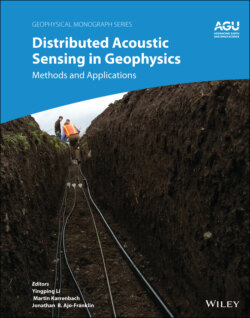Читать книгу Distributed Acoustic Sensing in Geophysics - Группа авторов - Страница 47
2.5.2. Common‐Mode Noise
ОглавлениеThe entire length of fiber from the IU to the end of the sensing fiber responds to any sound‐imparting strain on the optical fiber; further, the IU is sensitive to sound. All sounds hitting the IU impose an unwanted signal simultaneously on all data channels. This unwanted signal is called “common‐mode noise” or “horizontal noise,” because it appears as horizontal streaks on the data record. Therefore, it is important to consider keeping the area surrounding the IU quiet and, ideally, isolated from ground motion using a vibration‐isolation table. Even with sound isolation, it is still likely that the derived strain rate data will exhibit common‐mode noise.
Figure 2.6 Strain rate VSP data collected with a vibrator – (top row) uncorrelated trace without fading; (second row) uncorrelated trace with fading between 10 and 12 s; (third row) corresponding correlated trace without fading; and (fourth row) corresponding correlated trace with fading.
Figure 2.7 (a) single sweep using Frequency 1 – note the prominent fading at channels 38, 109, 169, and 223; (b) single sweep using Frequency 2 – note the prominent fading at channels 9, 128, 221, and 252; (c) weighted stack of data from both frequencies – note the strong reduction in fading; and (d) corresponding traces for channels 109 and 221, where the red trace is the faded trace, the blue is not faded, and the black trace is the weighted stack.
Figure 2.8 (left) shows a record exhibiting common‐mode noise, which is the horizontal noise that stripes across all channels. Figure 2.8 (right) shows the same record after signal processing has been applied to remove the common‐mode noise. An estimate of the noise can be created by stacking together all the traces in the record. As long as the actual desired seismic signal is changing significantly across the traces, the seismic signal will cancel itself, and only the common‐mode noise will remain in the stack. This stacked trace, normalized by the number of traces in the record, is then subtracted from each trace in the record to obtain the denoised record.
Figure 2.8 (Left) Strain rate record showing common‐mode noise; (right) same record following common‐mode noise removal.
